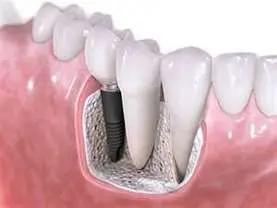Implant Dentist in Joliet IL
Before development of dental implants, dentures were the only alternative to replacing a missing tooth or teeth.


Implants are synthetic structures that are placed in the area of the tooth normally occupied by the root. Implants are anchored to the jawbone or metal framework on the bone and act as a foundation for an artificial tooth or permanent bridge. In some cases, implants can be used to attach dentures.
Not everyone is a candidate for a dental implant, however. For a successful implant to take hold, a candidate must have proper bone density and have a strong immune system. In all cases, dental implants require strict oral hygiene.
Implants are so well designed that they mimic the look and feel of natural teeth. Implants are usually made of a synthetic yet biocompatible material like metal or ceramic.
Surgery is necessary to prepare the area for an implant and place the implant in the mouth. Following the procedure, a period of time is required for the implant to take hold and for bone tissue to build up and anchor the device. In some cases, metal posts are inserted into the implant during a follow-up procedure to connect the tooth.
Because implants require surgery, patients are administered anesthesia and, if necessary, antibiotics to stave off infection following the procedure.
Like any restoration, implants require diligent oral hygiene and proper care to ensure they last a long time
Before Placing an Implant
Not all people are good candidates to get dental implants. A person who is most suitable is someone who is in good health, has healthy gums, and has enough bone in his or her jaw to allow an implant to be placed in the jawbone. To determine if you are suitable to get an implant, you will have to be examined by a dental professional.
Some people are interested in getting implants to replace teeth that have been missing for a number of years. Others may need implants to replace teeth that were extracted recently because of severe decay, periodontal (gum) disease, infection or injury. In some cases, the teeth can be extracted and the implant placed at the same time. However, if you have a severe infection in a tooth root or your gums, your dentist may wait a few months after removing the teeth to allow the area to heal.
Before a dental implant is placed, you may need to have the bone in the area built up to increase the chance of success. This is a common procedure called bone grafting or augmentation. You may have the bone graft done and get the implants at the same time, but your dental specialist may decide to do the bone-graft procedure first and give the bone time to heal before placing the implants. If the bone graft is done first, you will need 4 to 12 months to heal before having the implants placed in your jawbone. However, you can wear your dentures or bridge during this time, so you won't be without teeth.
Placing the Implants
Most implants are placed using a two-step process, although some newer implants can be placed in one step. What follows, is a description of how the two-step process works.
The First Surgery
You may be given antibiotics and pain medication to take before the surgery. Your dentist will use local anesthesia for the procedure and will offer you sedation if you want it. You can be sedated by taking medication by mouth, or the medication can be delivered through an intravenous line (a needle attached to a small tube placed in a vein in your arm).
To place the implants, the surgeon first will make an incision (cut) in your gums to expose the bone. He or she then will drill a hole in the bone for the implant, and place the implant in the hole. The surgeon probably will take an X-ray of the area to make sure the implant is where it should be. The surgeon will then stitch (suture) your gum closed over the implant. The time required for this procedure depends on the number of implants being placed and whether or not bone grafting is being done at the same time. In most cases, placing a single dental implant requires about one hour. You will feel some pain after this procedure. The level of discomfort depends on the person, but generally it has been described as relatively mild.
If the implant is placed in the front of your mouth, your dentist will give you a temporary denture or bridge so that you do not have to be without teeth. He or she will discuss options with you before the surgery.
After your surgery, your surgeon will give you antibiotics and pain medication. He or she also will give you instructions to follow. These will include:
Don't spit, suck on straws or smoke. This can dislodge blood clots and slow healing.
Eat only soft food to avoid injuring your gum tissues.
Don't try to clean the implant area for the next one to two weeks, but clean the rest of your mouth normally. Your dentist may give you an antibacterial rinse to help keep the area clean.
You will return to the surgeon 7 to 10 days later to have your stitches removed.
After the implant is placed in your jaw, you will have to wait several months for the bone to bond with the implant. This usually takes 3 or 4 months in the lower jaw and 5 or 6 months in the upper jaw. During this time, the head of the implant usually remains hidden under your gum.
The Second Surgery
After the implants have integrated (attached) with the surrounding bone, you are ready for the second surgery. After giving you local anesthesia, your surgeon will make a small incision in the gum to expose the implant. He or she will remove a protective screw from the implant and replace it with a metal healing abutment (collar). The healing abutment looks like a small metal cylinder that sits above your gums in the area where your tooth would be and maintains the space so that the gums heal correctly around the implant.
In a very small percentage of cases, the implants will not have successfully bonded with the bone. If this happens, your dentist either can remove the implants and immediately replace them with slightly wider ones, or remove them and allow the area to heal for several months before making a second attempt.
Some dentists are now using one-stage implants. These implants are placed in the jaw and remain exposed in the mouth so that no second surgery is needed.
Restoration
Generally, you will go to your dentist or prosthodontist two or three weeks following the second surgery to start the process of having your crown, bridge or denture made.
Complications from Surgery
Any surgery carries the possibility of complications. Complications of implant surgery include bleeding, infection and injury to nerves, sinuses (located above your upper teeth) or nasal cavity.
When implants are used to replace lower teeth, your dentist could nick the nerve that runs through the jawbone during drilling. This can cause pain or numbness. If numbness occurs, it usually affects the lower part of the lip and chin or one side of the tongue. It can last for several months until the nerve heals or it may be permanent.
In the upper jaw, there is the possibility of drilling through the jawbone into one of your sinuses or nasal cavity, which could result in an infection. To avoid this, special X-rays will be taken prior to your surgery will help the surgeon to determine where the nerves, sinuses and nasal cavity are located.
Implant Failure
Implant surgery is successful more than 90% of the time.
Occasionally, an implant fails to bond with the surrounding bone. This is usually discovered at the second stage surgery when the implant is uncovered and the surgeon finds it is loose. In this case, the "failed" implant has to be removed. Another implant can be placed either immediately or at a later visit.
Potential reasons for implants failing to integrate with surrounding bone include:
Surgical trauma
Infection around the implant
Smoking -- This appears to decrease blood flow to the healing gums and bone, which could interfere with the bonding process.
Lack of healthy bone -- If there is not enough bone for the implant to remain stable, the implant may move around within the bone and bonding will not occur.
Titanium allergies -- These are extremely rare.
Problems also can develop years after implants are placed. For example, just like natural teeth and gums, the gums around implants can become infected by bacteria, leading to a form of periodontal disease called periimplantitis. If left untreated, this condition can cause bone loss, which could cause the implant to become loose and have to be removed. Generally, this situation can be treated using procedures that are very similar to those used to treat periodontal disease affecting natural teeth.
Another type of complication that can happen over time is the implant-supported restoration (crown, bridge or denture) can break, or the implant itself can fracture. This usually happens if your bite (the way your teeth come together) is not aligned properly. If your bite is off, too much force might be placed on the restoration or implant. Broken restorations often can be repaired. However, a fractured implant has to be removed.
A broken implant or an implant that fails because of an infection can be replaced with a new implant
Benefits of Full Arch Implants with Overdentures
Denture stablized with implants
Possible to use existing dentures
Removable
Simple and Inexpensive
Offers a long-lasting solution, often for life
Renewed confidence and improved quality of life as well
Installing Full Arch Implants with Overdentures
The course of treatment described here is one of several options available. Consult your dentist to find out what the best solution is for you, given your specific condition.

1: Before the procedure
The dentist determines what needs to be done and prepares both himself and the patient for the coming treatment procedure.

2: Installing the implant
The first step is installing dental implants to replace the lost tooth roots. In this case, two implants are used. Four implants may be placed in cases for added overdenture retention. Temporary dentures may be worn that enable you to eat and function like normal while waiting for the permanent overdenture to be installed.

3: Attaching ball/bar and making overdentures
A ball or bar is then attached on top of the implants and the overdentures installed over. The ball or bar acts as a clip that enables the overdentures to snap securely in place.

4: End result
The removable overdentures are securely clipped on top of the implant with the ball/bar giving the strength and stability that allows you to better than with conventional dentures.
Source from nobel Biocare
-
"Mini" Implants
-
We are very excited to offer this service to our patients. Those who have had their dentures stabilized with mini dental implants find that they are able to eat and speak better than ever. If you have a denture that is giving you trouble while eating or speaking, denture stabilization with mini dental implants may be right for you. Call Northern Quality Dental to schedule an appointment.Clinical Picture of lower denture mini implant placement day of surgery
Patient Resource for Mini Implants

In some cases, mini implants are ideal for single tooth replacement as well. Ask Dr. Seymour!






